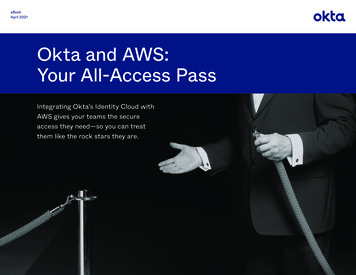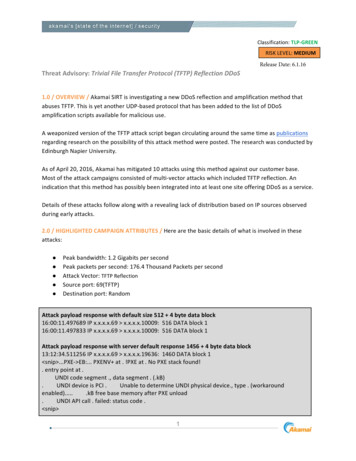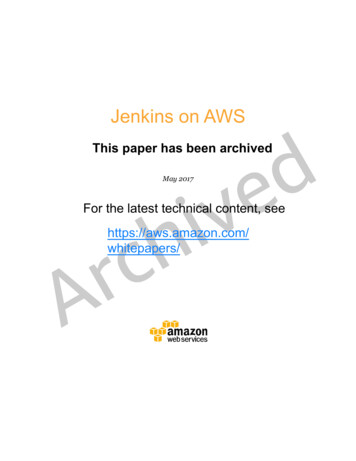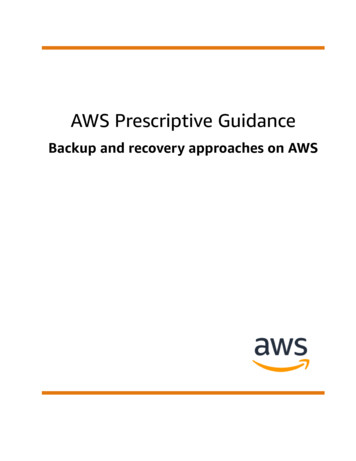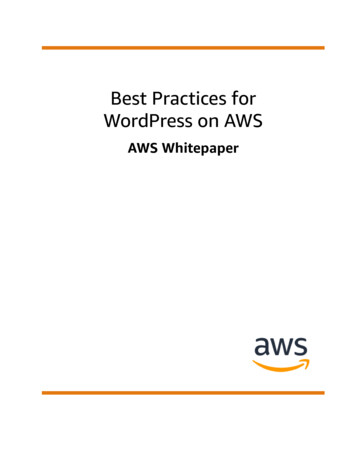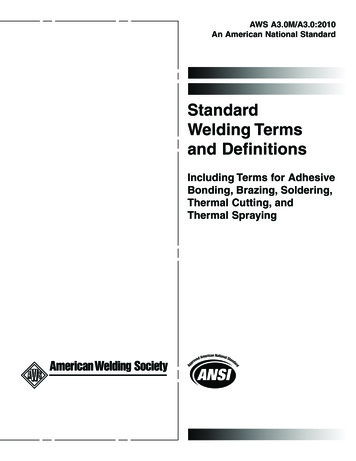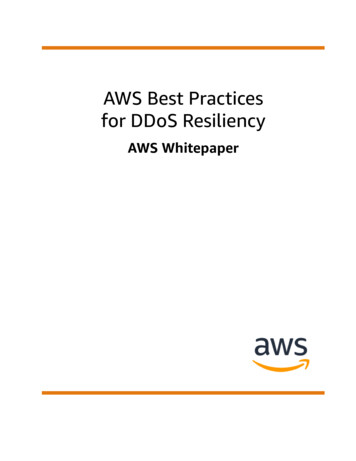
Transcription
AWS Best Practicesfor DDoS ResiliencyAWS Whitepaper
AWS Best Practices for DDoS Resiliency AWS WhitepaperAWS Best Practices for DDoS Resiliency: AWS WhitepaperCopyright Amazon Web Services, Inc. and/or its affiliates. All rights reserved.Amazon's trademarks and trade dress may not be used in connection with any product or service that is notAmazon's, in any manner that is likely to cause confusion among customers, or in any manner that disparages ordiscredits Amazon. All other trademarks not owned by Amazon are the property of their respective owners, who mayor may not be affiliated with, connected to, or sponsored by Amazon.
AWS Best Practices for DDoS Resiliency AWS WhitepaperTable of ContentsAbstract . 1Abstract . 1Are you Well-Architected? . 1Introduction: Denial of Service attacks . 2Infrastructure layer attacks . 3UDP reflection attacks . 3SYN flood attacks . 4Application layer attacks . 5Mitigation techniques . 7Best practices for DDoS mitigation . 10Infrastructure layer defense (BP1, BP3, BP6, BP7) . 10Amazon EC2 with Auto Scaling (BP7) . 11Elastic Load Balancing (BP6) . 11Use AWS Edge locations for scale (BP1, BP3) . 12Web application delivery at the edge (BP1) . 12Protect network traffic further from your origin using AWS Global Accelerator (BP1) . 13Domain Name Resolution at the Edge (BP3) . 13Application layer defense (BP1, BP2) . 13Detect and filter malicious web requests (BP1, BP2) . 14Automatically mitigate application-layer DDoS events (BP1, BP2, BP6) . 14Attack surface reduction . 16Obfuscating AWS resources (BP1, BP4, BP5) . 16Security groups and Network ACLs (BP5) . 16Protecting your origin (BP1, BP5) . 17Protecting API endpoints (BP4) . 17Operational techniques . 19Visibility . 19Visibility and protection management across multiple accounts . 23Support . 24Conclusion . 26Contributors . 27Further reading . 28Document revisions . 29Notices . 30AWS glossary . 31iii
AWS Best Practices for DDoS Resiliency AWS WhitepaperAbstractAWS Best Practices for DDoSResiliencyPublication date: April 13, 2022 (Document revisions (p. 29))AbstractIt’s important to protect your business from the impact of Distributed Denial of Service (DDoS) attacks,as well as other cyberattacks. Keeping customer trust in your service by maintaining the availability andresponsiveness of your application is high priority. You also want to avoid unnecessary direct costs whenyour infrastructure must scale in response to an attack. Amazon Web Services (AWS) is committed toproviding you with the tools, best practices, and services to defend against bad actors on the internet.Using the right services from AWS helps ensure high availability, security, and resiliency.In this whitepaper, AWS provides you with prescriptive DDoS guidance to improve the resiliency ofapplications running on AWS. This includes a DDoS-resilient reference architecture that can be used asa guide to help protect application availability. This whitepaper also describes different attack types,such as infrastructure layer attacks and application layer attacks. AWS explains which best practices aremost effective to manage each attack type. In addition, the services and features that fit into a DDoSmitigation strategy are outlined, along with how each one can be used to help protect your applications.This paper is intended for IT decision makers and security engineers who are familiar with the basicconcepts of networking, security, and AWS. Each section has links to AWS documentation that providesmore detail on the best practice or capability.Are you Well-Architected?The AWS Well-Architected Framework helps you understand the pros and cons of the decisions you makewhen building systems in the cloud. The six pillars of the Framework allow you to learn architectural bestpractices for designing and operating reliable, secure, efficient, cost-effective, and sustainable systems.Using the AWS Well-Architected Tool, available at no charge in the AWS Management Console (sign-inrequired), you can review your workloads against these best practices by answering a set of questions foreach pillar.For more expert guidance and best practices for your cloud architecture—reference architecturedeployments, diagrams, and whitepapers, refer to the AWS Architecture Center.1
AWS Best Practices for DDoS Resiliency AWS WhitepaperIntroduction: Denial of ServiceattacksA Denial of Service (DoS) attack is a deliberate attempt to make a website or application unavailableto users, such as by flooding it with network traffic. Attackers use a variety of techniques that consumelarge amounts of network bandwidth or tie up other system resources, disrupting access for legitimateusers. In its simplest form, a lone attacker uses a single source to carry out a DoS attack against a target,as shown in the following figure.A diagram depicting a DoS attackIn a Distributed Denial of Service (DDoS) attack, an attacker uses multiple sources to orchestrate anattack against a target. These sources can include distributed groups of malware infected computers,routers, IoT devices, and other endpoints. The following figure shows a network of compromised hoststhat participate in the attack, generating a flood of packets or requests to overwhelm the target.A diagram depicting a DDoS attackThere are seven layers in the Open Systems Interconnection (OSI) model, and they are described in thefollowing table. DDoS attacks are most common at layers three, four, six, and seven.2
AWS Best Practices for DDoS Resiliency AWS WhitepaperInfrastructure layer attacks Layer three and four attacks correspond to the Network and Transport layers of the OSI model. Withinthis whitepaper, AWS refers to these collectively as infrastructure layer attacks. Layers six and seven attacks correspond to the Presentation and Application layers of the OSI model.This whitepaper addresses these together as application layer attacks.This paper discusses these attack types in the sections that follow.Table 1 — OSI model#LayerUnitDescriptionVector examples7ApplicationDataNetwork processto applicationHTTP floods, DNSquery floods6PresentationDataDatarepresentationand encryptionTransport LayerSecurity ansportSegmentsEnd-to-endconnections andreliabilitySynchronize (SYN)floods3NetworkPacketsPathdetermination andlogical addressingUser DatagramProtocol (UDP)reflection attacks2Data LinkFramesPhysicaladdressingN/A1PhysicalBitsMedia, signal,and binarytransmissionN/AInfrastructure layer attacksThe most common DDoS attacks, User Datagram Protocol (UDP) reflection attacks and SYN floods, areinfrastructure layer attacks. An attacker can use either of these methods to generate large volumesof traffic that can inundate the capacity of a network or tie up resources on systems such as servers,firewalls, intrusion prevention system (IPS), or load balancer. While these attacks can be easy to identify,to mitigate them effectively, you must have a network or systems that scale up capacity more rapidlythan the inbound traffic flood. This extra capacity is necessary to either filter out or absorb the attacktraffic freeing up the system and application to respond to legitimate customer traffic.UDP reflection attacksUDP reflection attacks exploit the fact that UDP is a stateless protocol. Attackers can craft a valid UDPrequest packet listing the attack target’s IP address as the UDP source IP address. The attacker has nowfalsified—spoofed—the UDP request packet’s source IP. The UDP packet contains the spoofed source IPand is sent by the attacker to an intermediate server. The server is tricked into sending its UDP responsepackets to the targeted victim IP rather than back to the attacker’s IP address. The intermediate server3
AWS Best Practices for DDoS Resiliency AWS WhitepaperSYN flood attacksis used because it generates a response that is several times larger than the request packet, effectivelyamplifying the amount of attack traffic sent to the target IP address.The amplification factor is the ratio of response size to request size, and it varies depending on whichprotocol the attacker uses: DNS, Network Time Protocol (NTP), Simple Service Directory Protocol (SSDP),Connectionless Lightweight Directory Access Protocol (CLDAP), Memcached, Character GeneratorProtocol (CharGen), or Quote of the Day (QOTD).For example, the amplification factor for DNS can be 28 to 54 times the original number of bytes. So, ifan attacker sends a request payload of 64 bytes to a DNS server, they can generate over 3400 bytes ofunwanted traffic to an attack target. UDP reflection attacks are accountable for larger volume of trafficin comparison to other attacks. The following figure illustrates the reflection tactic and amplificationeffect.A diagram depicting a UDP reflection attackSYN flood attacksWhen a user connects to a Transmission Control Protocol (TCP) service, such as a web server, their clientsends a SYN packet. The server returns a synchronization-acknowledgement (SYN-ACK) packet, andfinally the client responds with an acknowledgement (ACK) packet, which completes the expected threeway handshake. The following image illustrates this typical handshake.4
AWS Best Practices for DDoS Resiliency AWS WhitepaperApplication layer attacksA diagram depicting a SYN three-way handshakeIn a SYN flood attack, a malicious client sends a large number of SYN packets, but never sends the finalACK packets to complete the handshakes. The server is left waiting for a response to the half-open TCPconnections and eventually runs out of capacity to accept new TCP connections. This can prevent newusers from connecting to the server. The attack is trying to tie up available server connections so thatresources are not available for legitimate connections. While SYN floods can reach up tohundredsofbillions of bits per second (Gbps),the primary purpose of the attack is not to increase SYN traffic volume.Application layer attacksAn attacker may target the application itself by using a layer 7 or application layer attack. In theseattacks, similar to SYN flood infrastructure attacks, the attacker attempts to overload specific functionsof an application to make the application unavailable or unresponsive to legitimate users. Sometimesthis can be achieved with very low request volumes that generate only a small volume of network traffic.This can make the attack difficult to detect and mitigate. Examples of application layer attacks includeHTTP floods, cache-busting attacks, and WordPress XML-RPC floods. In an HTTP flood attack, an attacker sends HTTP requests that appear to be from a valid user of theweb application. Some HTTP floods target a specific resource, while more complex HTTP floodsattempt to emulate human interaction with the application. This can increase the difficulty of usingcommon mitigation techniques such as request rate limiting. Cache-busting attacks are a type of HTTP flood that uses variations in the query string to circumventcontent delivery network (CDN) caching. Instead of being able to return cached results, the CDN mustcontact the origin server for every page request, and these origin fetches cause additional strain on theapplication web server. With a WordPress XML-RPC flood attack, also known as a WordPress pingback flood, an attacker targetsa website hosted on the WordPress content management software. The attacker misuses the XML-RPCAPI function to generate a flood of HTTP requests. The pingback feature allows a website hosted onWordPress (Site A) to notify a different WordPress site (Site B) through a link that Site A has createdto Site B. Site B then attempts to fetch Site A to verify the existence of the link. In a pingback flood,the attacker misuses this capability to cause Site B to attack Site A. This type of attack has a clearsignature: "WordPress: is typically present in the User-Agent of the HTTP request header.5
AWS Best Practices for DDoS Resiliency AWS WhitepaperApplication layer attacksThere are other forms of malicious traffic that can impact an application’s availability. Scraper botsautomate attempts to access a web application to steal content or record competitive information,such as pricing. Brute force and credential stuffing attacks are programmed efforts to gain unauthorizedaccess to secure areas of an application. These are not strictly DDoS attacks; but their automated naturecan look similar to a DDoS attack and they can be mitigated by implementing some of the same bestpractices to be covered in this paper.Application layer attacks can also target Domain Name System (DNS) services. The most common ofthese attacks is a DNS query flood in which an attacker uses many well-formed DNS queries to exhaustthe resources of a DNS server. These attacks can also include a cache-busting component where theattacker randomizes the subdomain string to bypass the local DNS cache of any given resolver. As aresult, the resolver can’t take advantage of cached domain queries and must instead repeatedly contactthe authoritative DNS server, which amplifies the attack.If a web application is delivered over Transport Layer Security (TLS), an attacker can also choose toattack the TLS negotiation process. TLS is computationally expensive so an attacker, by generatingextra workload on the server to process unreadable data (or unintelligible (ciphertext) as a legitimatehandshake, can reduce server’s availability. In a variation of this attack, an attacker completes the TLShandshake but perpetually renegotiates the encryption method. An attacker can alternatively attempt toexhaust server resources by opening and closing many TLS sessions.6
AWS Best Practices for DDoS Resiliency AWS WhitepaperMitigation techniquesSome forms of DDoS mitigation are included automatically with AWS services. DDoS resilience can beimproved further by using an AWS architecture with specific services, covered in the following sections,and by implementing additional best practices for each part of the network flow between users and yourapplication.All AWS customers can benefit from the automatic protections of AWS Shield Standard at no additionalcharge. AWS Shield Standard defends against the most common and frequently occurring network andtransport layer DDoS attacks that target your website or applications. This protection is always on, preconfigured, static, and provides no reporting or analytics. It is offered on all AWS services and in everyAWS Region. In AWS Regions, DDoS attacks are detected and the Shield Standard system automaticallybaselines traffic, identifies anomalies, and, as necessary, creates mitigations. You can use AWS ShieldStandard as part of a DDoS-resilient architecture to protect both web and non-web applications.You can also utilize AWS services that operate from edge locations, such as Amazon CloudFront, AWSGlobal Accelerator, and Amazon Route 53 to build comprehensive availability protection against allknown infrastructure layer attacks. These services are part of the AWS Global Edge Network, and canimprove the DDoS resilience of your application when serving any type of application traffic from edgelocations distributed around the world. You can run your application in any AWS Region, and use theseservices to protect your application availability and optimize the performance of your application forlegitimate end users.Benefits of using Amazon CloudFront, Global Accelerator, and Amazon Route 53 include: Access to internet and DDoS mitigation capacity across the AWS Global Edge Network. This is useful inmitigating larger volumetric attacks, which can reach terabit scale. AWS Shield DDoS mitigation systems are integrated with AWS edge services, reducing time-tomitigate from minutes to sub second. Stateless SYN Flood mitigation techniques proxy and verify incoming connections before passingthem to the protected service. This ensures that only valid connections reach your application whileprotecting your legitimate end users against false positives drops. Automatic traffic engineering systems that disperse or isolate the impact of large volumetric DDoSattacks. All of these services isolate attacks at the source before they reach your origin, which meansless impact on systems protected by these services. Application layer defense when combined with AWS Web Application Firewall (AWS WAF) that doesnot require changing current application architecture (for example, in an AWS Region or on-premisesdata center).There is no charge for inbound data transfer on AWS and you do not pay for DDoS attack traffic thatis mitigated by AWS Shield. The following architecture diagram includes AWS Global Edge Networkservices.7
AWS Best Practices for DDoS Resiliency AWS WhitepaperDDoS-resilient reference architectureThis architecture includes several AWS services that can help you improve your web application’sresiliency against DDoS attacks. The Summary of Best Practices table provides a summary of theseservices and the capabilities that they can provide. AWS has tagged each service with a best practiceindicator (BP1, BP2) for easier reference within this document. For example, an upcoming sectiondiscusses the capabilities provided by Amazon CloudFront and Global Accelerator that includes the bestpractice indicator BP1.Table 2 - Summary of best practicesAWS EdgeAWS RegionUsingAmazonCloudFront(BP1) withAWS WAF(BP2)Using GlobalAccelerator(BP1)UsingAmazonRoute 53(BP3)UsingElastic LoadBalancing(BP6) withAWS WAF(BP2)UsingSecurityGroups andnetworkACLs inAmazon VPC(BP5)UsingAmazonElasticComputeCloud(AmazonEC2) AutoScaling(BP7)Layer 3 (forexample,UDPreflection)attackmitigation Layer 4 (forexample,SYN flood)attackmitigation Layer 6 (forexample,TLS) attackmitigation 8
AWS Best Practices for DDoS Resiliency AWS WhitepaperAWS EdgeAWS RegionReduceattacksurface Scale toabsorbapplicationlayer traffic Layer 7(applicationlayer) attackmitigation (*) (*) (*) Geographic isolation anddispersionof excesstraffic andlarger DDoSattacks (*): if usedwith AWSWAF withApplicationLoadBalancerAnother way to improve your readiness to respond to and mitigate DDoS attacks is by subscribing toAWS Shield Advanced.You receive tailored detection based on: Specific traffic patterns of your application. Protection against Layer 7 DDoS attacks including AWS WAF at no additional cost. Access to 24x7 specialized support from the AWS Shield Response Team (AWS SRT). Centralized management of security policies through AWS Network Firewall. Cost protection to safeguard against scaling charges resulting from DDoS-related usage spikes.This optional DDoS mitigation service helps protect applications hosted on any AWS Region. The serviceis available globally for CloudFront, Route 53, and Global Accelerator. Using Shield Advanced with ElasticIP addresses allows you to protect Network Load Balancer (NLBs) or Amazon EC2 instances.Benefits of using AWS Shield Advanced include: Access to the AWS SRT for assistance with mitigating DDoS attacks that impact application availability. DDoS attack visibility by using the AWS Management Console, API, and Amazon CloudWatch metricsand alarms. Access to the history of all DDoS events from the past 13 months. Access to AWS web application firewall (AWS WAF), at no additional cost for the mitigation ofapplication layer DDoS attacks (when used with Amazon CloudFront or Application Load Balancer). Automatic baselining of web traffic attributes, when used with AWS WAF.9
AWS Best Practices for DDoS Resiliency AWS WhitepaperBest practices for DDoS mitigation Access to AWS Firewall Manager, at no additional cost, for automated policy enforcement. Sensitive detection thresholds that route traffic into the DDoS mitigation system earlier and canimprove time-to-mitigate attacks against Amazon EC2 or Network Load Balancer, when used with anElastic IP address. Cost protection that enables you to request a limited refund of scaling-related costs that result from aDDoS attack. Enhanced service level agreement that is specific to AWS Shield Advanced customers. Proactive engagement from the AWS SRT when a Shield event is detected. Protection groups that enable you to bundle resources, providing a self-service way to customize thescope of detection and mitigation for your application by treating multiple resources as a single unit.Resource grouping improves the accuracy of detection, minimizes false positives, eases automaticprotection of newly created resources, and accelerates the time to mitigate attacks against manyresources that comprise a single application. For information about protection groups, refer to ShieldAdvanced protection groups.For a complete list of AWS Shield Advanced features and for more information about AWS Shield, referto How AWS Shield works.Best practices for DDoS mitigationIn the following sections, each of the recommended best practices for DDoS mitigation are described inmore depth. For a quick and easy-to-implement guide on building a DDoS mitigation layer for static ordynamic web applications, refer to How to Help Protect Dynamic Web Applications Against DDoS Attacksby Using Amazon CloudFront and Amazon Route 53.Infrastructure layer defense (BP1, BP3, BP6, BP7)In a traditional datacenter environment, you can mitigate infrastructure layer DDoS attacks by usingtechniques like overprovisioning capacity, deploying DDoS mitigation systems, or scrubbing trafficwith the help of DDoS mitigation services. On AWS, DDoS mitigation capabilities are automaticallyprovided; but you can optimize your application’s DDoS resilience by making architecture choices thatbest leverage those capabilities and also allow you to scale for excess traffic.Key considerations to help mitigate volumetric DDoS attacks include ensuring that enough transitcapacity and diversity are available and protecting AWS resources, like Amazon EC2 instances, againstattack traffic.Some Amazon EC2 instance types support features that can more easily handle large volumes oftraffic, for example, up to 100 Gbps network bandwidth interfaces and enhanced networking. Thishelps prevent interface congestion for traffic that has reached the Amazon EC2 instance. Instances thatsupport enhanced networking provide higher input/output (I/O) performance, higher bandwidth, andlower CPU utilization compared to traditional implementations. This improves the ability of the instanceto handle large volumes of traffic and ultimately makes them highly resilient against packets per second(pps) load.To allow this high level of resilience, AWS recommends using Amazon EC2 Dedicated Instances, orAmazon EC2 instances with higher networking throughput that have an "N" suffix and support forEnhanced Networking with up to 100 Gbps of Network bandwidth, for example, c6gn.16xlarge andc5n.18xlarge or metal instances (such as c5n.metal).For more information about Amazon EC2 instances that support 100 Gigabit network interfaces andenhanced networking, refer to Amazon EC2 Instance Types.The module required for enhanced networking and the required enaSupport attribute set are includedwith Amazon Linux 2 and the latest versions of the Amazon Linux AMI. Therefore, if you launch an10
AWS Best Practices for DDoS Resiliency AWS WhitepaperAmazon EC2 with Auto Scaling (BP7)instance with a hardware virtual machine (HVM) version of Amazon Linux on a supported instance type,enhanced networking is already enabled for your instance. For more information, refer to Test whetherenhanced networking is enabled .For more information, refer to Test whether enhanced networking is enabled. For moreinformationabout how to enable enhanced networking, refer to Enhanced networking on Linux.Amazon EC2 with Auto Scaling (BP7)Another way to mitigate both infastructure and application layer attacks is to operate at scale. If youhave web applications, you can use load balancers to distribute traffic to a number of Amazon EC2instances that are overprovisioned or configured to automatically scale. These instances can handlesudden traffic surges that occur for any reason, including a flash crowd or an application layer DDoSattack. You can set Amazon CloudWatch alarms to initiate Auto Scaling to automatically scale the size ofyour Amazon EC2 fleet in response to events that you define, such as CPU, RAM, Network I/O, and evencustom metrics.This approach protects application availability when there’s an unexpected increase in request volume.When using Amazon CloudFront, Application Load Balancer, Classic Load Balancers, or Network LoadBalancer with your application, TLS negotiation is handled by the distribution (Amazon CloudFront) or bythe load balancer. These features help protect your instances from being impacted by TLS-based attacksby scaling to handle legitimate requests and TLS abuse attacks.For more information about using Amazon CloudWatch to invoke Auto Scaling, refer to MonitoringAmazon CloudWatch metrics for your Auto Scaling groups and instances.Amazon EC2 provides resizable compute capacity so that you can quickly scale up or down asrequirements change. You can scale horizontally by automatically adding instances to your application byscaling the size of your Amazon EC2 Auto Scaling group, and you can scale vertically by using larger EC2instance types.Elastic Load Balancing (BP6)Large DDoS attacks can overwhelm the capacity of a single Amazon EC2 instance. With Elastic LoadBalancing (ELB), you can reduce the risk of overloading your application by distributing traffic acrossmany backend instances. Elastic Load Balancing can scale automatically, allowing you to manage largervolumes when you have unanticipated extra traffic, for example, due to flash crowds or DDoS attacks.For applications built within an Amazon VPC, there are three types of ELBs to consider, depending onyour application type: Application Load Balancer (ALB), Classic Load Balancer (CLB), and Network LoadBalancer (NLB).For web applications, you can use the Application Load Balancer to route traffic based on content andaccept only well-formed web requests. Application Load Balancer blocks many common DDoS attacks,such as SYN floods or UDP reflection attacks, protecting your application from the attack. ApplicationLoad Balancer automatically scales to absorb the additional traffic when these types of attacks aredetected. Scaling activities due to infrastructure layer attacks are transparent for AWS customers and donot affect your bill.For more information about protecting web applications with Application Load Balancer, refer to GettingStarted with Application Load Balancers.For TCP-based applications, you can use
application web server. With a WordPress XML-RPC flood attack, also known as a WordPress pingback flood, an attacker targets a website hosted on the WordPress content management software. The attacker misuses the XML-RPC API function to generate a flood of HTTP




